Six of the best: Cycling's most popular variété show
European Six Day track events are an unusual species of race. They're held in indoor velodromes,...
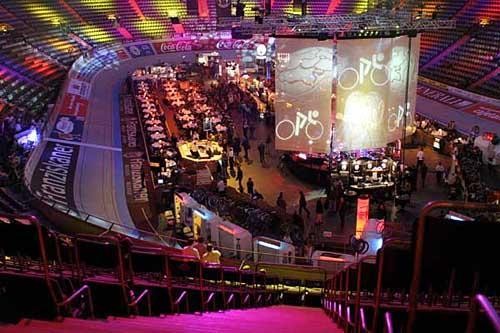
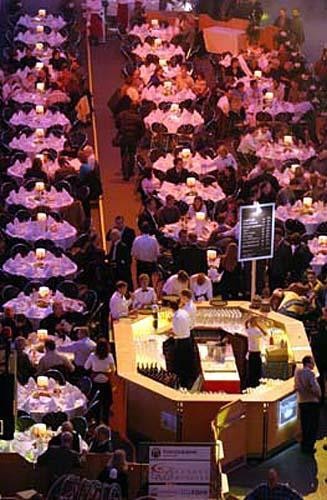
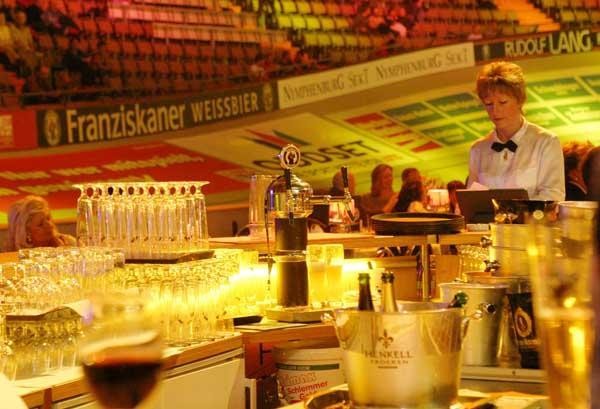
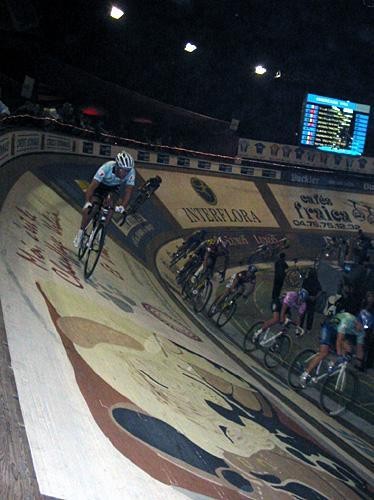
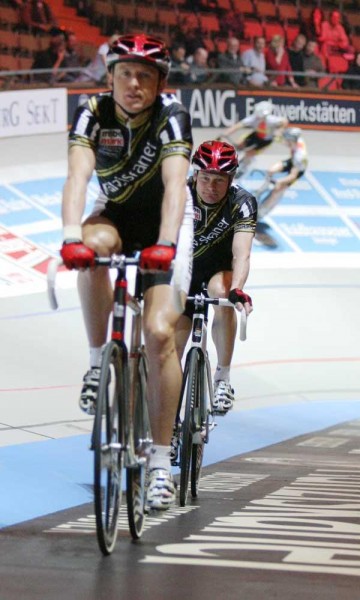
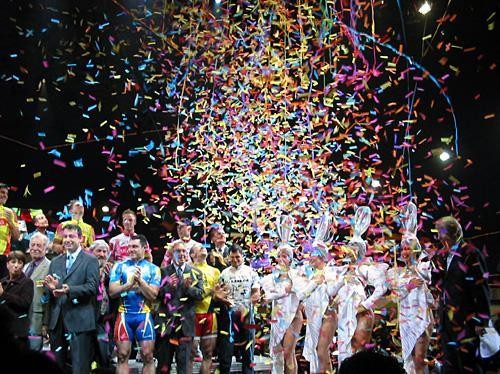
Tales from the (Six Day) peloton, November 18, 2004
European Six Day track events are an unusual species of race. They're held in indoor velodromes, during the evening (usually from 6pm to midnight), six evenings in a row. Most of the spectators are there to enjoy fine dining within the oval venue, meet friends and be entertained with music and artistic dance shows. And catch the racing, of course, which is very fast and confusing - anyone not acquainted with the rules and disciplines will literally lose track (sorry) of it.
So what are these bizarre events about? To answer that question, Cyclingnews' Hedwig Kröner kicks off first by digging up a little history...
Six Day races come from a time in cycling where athletic ability was proved by riding more than 500km with no freewheel, pedalling away for over a day from Bordeaux to Paris (577 km) or over the Alps from Milan to Munich (590 km), to name but two examples.
And after a velocipede factory in Birmingham, UK, invented a race in 1875 that went for more than 12 hours a day, six days in a row (excluding holy Sunday, of course), other organisers followed suit.
Speaking of suits, it was American businessmen who saw the potential of the event, and the first Six Day in the United States was held in Detroit in 1879. Not much is known of these pioneer races, except that they were scheduled to last from noon until midnight and were even held in places as far away as the Australian cities of Melbourne and Adelaide (1881), which boast a long and successful track cycling history, demonstrated most recently at the Athens Olympic Games.
About 10 years later, U.S. riders' racing times were raised to 18 hours a day, then to the full 24 hours a day a few more years later for a total of 144 hours on the bike - making it more of a survival test than a bike race. Teddy Hale, winner of the 1896 New York Six Day (and the first representative of the "League of the American Wheelman", USA Cycling's predecessor), said he had pedalled himself into a state of hypnosis, unwilling or unable to step off his bike - even although the race had come to its end!
Get The Leadout Newsletter
The latest race content, interviews, features, reviews and expert buying guides, direct to your inbox!
After three gruesome editions, authorities finally prohibited these six-day solo endurance tests. But instead of reducing racing the hours, competitors were given teammates to 'relieve' each other. In doing so, the original Six Day paired racing concept was born, known as the "Américaine" after its origins in New York's Madison Square Garden in late 1899, or the "Madison", as it is still called in Europe today.
Money makes the world go round
However, team racing didn't appeal to New Yorkers, accustomed to more spectacular one-man shows, and on the third day, organisers feared that they may be unable to pay the rent as they lacked the entrance fee income.
Only a witty trick from the event's doctor saved the day, as he decided to use media coverage to create the hype: initiating a press conference on his own accord, the doctor accused the organisers of forcing the riders to perform in terrible conditions, and claimed the mental strain caused the riders to retreat into hysteria. The medic provided the story, journalists loved it, and the people came back to see what it was all about!
This business-like approach lay the grounds for the trend Six Day races underwent henceforth: commercialisation of the sport. Sponsors got interested, orchestras were signed, food and drink were provided and bonus points were introduced to make the race more appealing to both the public and the riders, some who were starting to earn a living off their sport.
By the start of the 20th century, it was the American Six Day stars who took "their" races back to Europe. The first European outdoor Six Day with two-man teams was held in Toulouse, France in 1906.
Three years later, the race came to Germany for the inaugural Six Days of Berlin, and the German capital holds the record of having hosted the most "Sixes" in history, 2004 being the 93rd edition of the race. Second place on that list is New York with 70 Six Days - but the last one unfortunately took place place back in 1961.
The rise... and the fall
The sport continued to grow in "Old Europe" until the beginning of last century, and reached a peak of popularity in the 1930s where it flourished. In 1935, the successful German Six Day specialist Walter Sawall owned several villas as well as a private plane, making him the wealthiest pro cyclist at the time.
But with the Nazi regime in power in Germany, prohibiting Sixes from 1934 until the start of World War II, races and their riders moved back to the United States yet again. Continuation of the riders' fame and fortune was short-lived, however, as an irreversible decline took hold, spurred by changing leisure habits in the U.S. in the '50s and '60s and the growing popularity of road cycling and football. In America as well as in Australia, several attempts to revive the public's interest in velodromes failed, and the Six Days would never again captivate the masses like they used to.
In Europe, too, the pre-war boom did not last. But the track cycling monster lived on, fed by crowd incentives like cabaret shows, artistic circus spectacles and other entertainment, which varies according to the country and tradition of the particular event.
The Munich Six, for example, even offers a post-race club, where the party continues until early morning - though not for the riders, of course. With lots of beer and sausages, the atmosphere is very close to the famous Oktoberfest. In Grenoble, Tour de France finish-line speaker Daniel Mangeas commentates throughout the race, cabaret girls add to the flair and French wine and food make it hard to concentrate on the main reason why the arena is packed, the racing. Even with these additional goings-on, the cycling is still an essential part of the event, even if some Six Day pundits have argued that commercialisation has taken over the quality of racing.
Rules do exist
It's a long way between watching Sixes and actually understanding how they work.
The goal, however, is simple: the team with the most points after six nights wins. Of course, the riders don't circle around the track for 144 hours anymore; typically, total racing time is about four to five hours a night, totalling 1000-1500km in the end. Compared that to the world record set in 1924, the last year where riders had to pedal around the clock: the winning team covered a total of 4,544.2 km.
Since then, Six Day racing has become more humane... but also more complicated. As if it wasn't enough trying to distinguish which team is actually in front during a race where leading riders can hide inside the bunch because the track arena is, after all, a closed oval circuit, the teams score points in all sorts of track cycling disciplines, in all sorts of ways.
The Madison - the main event each night - typically covers between 40-60km. Two-men (sometimes three, but on very rare occassions) teams circle around the velodrome, trying to lap each other as well as score points every 20 laps in the intermediate sprints. Only one rider of each team is actually racing at any given time, while his partner rides neutralised at the top of the track's banking, ready to be thrown into the action every two or three laps with the handsling manoeuvre. Trying to lap other teams is the main objective, as laps determine final victory should two teams be equal on points - although every 100 points count for one lap.
In the Elimination race, the last rider after each sprint held every five laps or so is eliminated, and only the last sprint after a determined number of laps counts for points. The Points race is similar to the Madison but raced individually, opening up the possibility of a massage or a quick nap for one of the riders.
Organisers often throw in other events such as Derny or Stayer races, where each rider paces behind a small motorcycle called a "Derny", and Keirin races, where all riders follow behind one Derny before it pulls off for a final bunch sprint. Match Sprints between two riders are also a regular crowd pleaser at Six Days. Along with the Keirin, they often belong to a set of races performed only by sprinters and do not count for final Six Day points tally. Similarly, there are Junior and Women's events, but again, this is up to the race organisers.
Since the Sixes are not UCI-registered, every event has its own set of races and rules, which can vary substantially and change randomly. (An overview of track cycling disciplines can be found here.) So don't forget to get a racing programme beforehand!
The champions of the Six
The protagonists of Six Day races are track specialists, of course, many of them the world's best, but also a lot of road riders have used the velodrome to stay in shape and earn extra pocket money during the cold and rainy northern European winters.
Some continue to do so although even after a packed summer schedule. T-Mobile teammates Erik Zabel and Rolf Aldag like to join forces at the Dortmund Six Day, for example, but both of them have matched with other riders, as team composition is not subject to any rule. However, the "King of Six Days" beyond doubt is Belgian Patrick Sercu: with 88 victories to his account, he dominated the sport in the 70s, sometimes pairing with road legend Eddy Merckx, and continues to organise and direct a lot of European Six Days like Munich, Ghent, Bremen and Amsterdam. Second on the absolute victories ranking is Australian Danny Clarke with 74 wins, achieved mainly in the 80s and early 90s.
The most successful couple is the current Swiss pair Bruno Risi and Kurt Betschart, who have already topped every other pair in history with 34 overall victories. Other contemporary stars include the Italian Madison specialists Marco Villa and Silvio Martinello with 22 and 28 victories so far respectively; some say that if they had teamed up more often, they would have cracked Risi and Betschart's record.
Aussie-Belgian duo, Scott McGrory and Matthew Gilmore, have nine victories to their credit since 2000, while Alexander Aeschbach and Franco Marvulli, yet another Swiss duo, appear to be the next big thing on the Six Day circuit. But there are many riders to discover, like the Dutch Robert Slippens and Danny Stam, also on the rise, and German pair Andreas Kappes and Andreas Beikirch.
The show must go on!
Some critics argue that Six Days lack true sports competition because of the show aspect, despite outstanding physical performances so often displayed.
But as Patrick Sercu explained in an interview with British Cycling, track cycling actually depends on the Sixes: "On the one hand you have the Olympic Games, World Championships and the World Cup Series and on the other the Six Days and the other meetings, where the professional rider has to earn a living," he said.
"You see, the Olympics and the World's are where you make your reputation, and the Six Days and the other races are where you make your money," added the Six Day legend.
Just as the Sixes combine their exciting race programme with commercial and entertainment elements to be able to survive financially, this one-of-a-kind 'genre' gives riders a certain platform to earn a living and achieve even higher goals such as UCI-approved world records.
And for us ordinary people, Six Day races are a great way to enjoy the sport on winter evenings, while being served dinner with some friends and live shows to top it off. Why would anyone want to go to the cinema?
See also: What is six-day racing?; An overview of track racing
More Cylingnews features